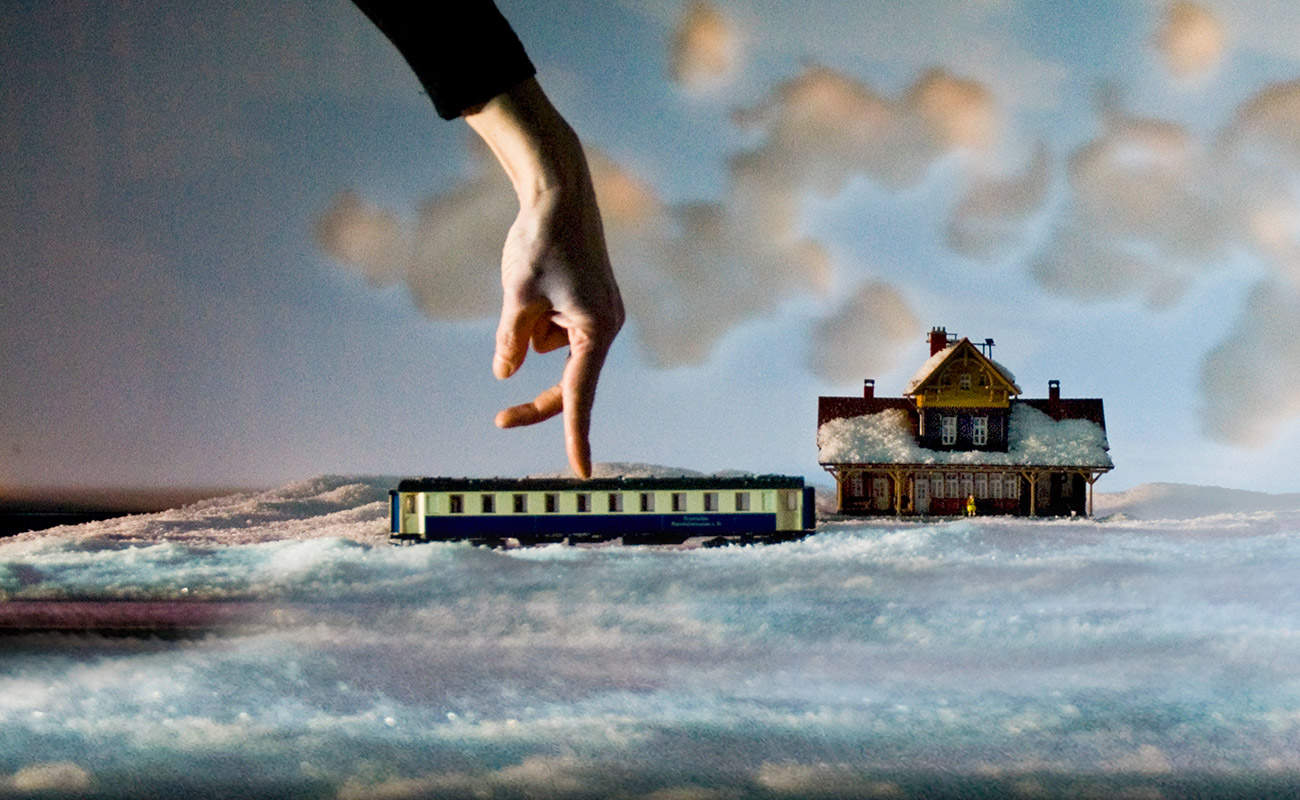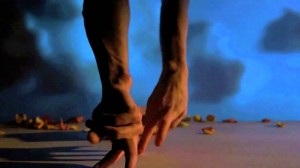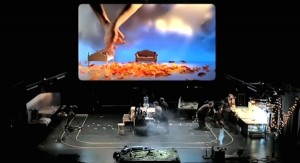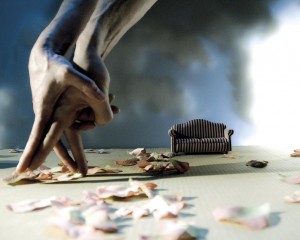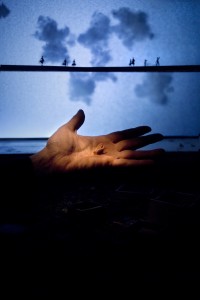Donald Hutera talks to Michèle Anne De Mey and Gregory Grosjean about Kiss & Cry, which comes to the London International Mime Festival 2017
‘When the magician shows you the trick, maybe the trick starts to be more magical.’
Now to be honest, I didn’t hear these words issuing from the lips of Jaco Van Dormael, the Belgian film-maker whose credits include Toto the Hero (1991), Mr Nobody (2009) and The Brand New Testament (2015). I’m also uncertain whether this paraphrase of Van Dormael was told to me by his partner of seventeen years, the choreographer Michèle Anne De Mey, or her fellow dance collaborator Gregory Grosjean, when I met them both in Bolgona, Italy, this autumn.
Maybe the source of the sentence doesn’t really matter. What counts is the idea being expressed so neatly, and how aptly it applies to the magical Kiss & Cry, which comes to the Barbican in February 2017, as part of the London International Mime Festival, presented under the auspices of Charleroi Danses.
Collectively created by Van Dormael, De Mey and Grosjean (along with the writer Thomas Gunzig, the cinematographer Julien Lambert, designer Sylvie Olivé and lighting man Nicolas Olivier), Kiss & Cry is an entrancing and gorgeous hybrid of a show that’s been on the international arts circuit for close to five years now.
By turns witty, poignant and spellbinding, this approximately 90-minute work has, since its 2012 premiere, racked up close to 300 performances in languages including Flemish, French, German, Greek, Italian, Portuguese, Spanish and Korean. The English version receives what De Mey deems quite a fairytale-like rendering by the young British actor Toby Regbo. Language is one of the ways that this vividly realised piece is tailored to each location in which it is performed. Heard only as an intermittent voice-over, Gunzig’s text is the poetic echo of imagery that could be described as consistently striking and cumulatively profound.
You could characterise Kiss & Cry itself as a piece of ‘live cinema,’ but one with a marvellous catch. The human hand is the star (or, as De Mey puts it, ‘the main character’) of the show, and it’s the hand or, more accurately, several hands that, in tandem with the camera (or, more accurately, two cameras) also do most of the ‘talking’ – by which I mean communicating – in this utterly ingenious and economical production. The familiar (and, no surprise, highly photogenic) five-fingered appendage is used as both a functional tool and, more significantly, a hugely expressive instrument. And it’s our privilege and pleasure to witness these hands travelling through a series of beautifully and cleverly constructed small-scale settings and situations that play literally and figuratively with size, and emotionally with time. Kiss & Cry is, in essence, like an act of collective dreaming into which we’re cordially invited.
One of the most wondrous things about this imaginative and uncommonly seductive performance is how multi-layered and multi-levelled it is, and yet so transparent in the meticulously stylised manner in which it touches upon evolution, mythology, romance, destiny versus chance and much more. Indeed, everything about Kiss & Cry is visible from the get-go.
‘Everybody onstage is playing with cinema,’ says De Mey when we meet in Bologna, where the production was presented at Teatro Arena del Sole as part of the 12th edition of the four-city Vie Festival. ‘The fabrication of the movie is what the audience sees.’ She stops speaking just long enough to think for a beat, and then corrects herself: ‘Everything is there for you to see – how we make the show and, at the same time, the results.’ Later, without meaning to contradict herself, she compares Kiss & Cry to a series of Russian matryoshka dolls, ‘one inside the other.’
Kiss & Cry features a cast of nine – De Mey and Grosjean, actor-dancers whose limbs do most of the performing, plus a clutch of technicians who are just as much interpreters of the work in their own right. This band of clever, miniaturist movie-makers keep themselves extraordinarily occupied with the common goal of imparting an elusive and often almost abstract narrative of longing, love and loss that unfolds via movement (of human flesh, principally in the form of hand puppetry; objects, props and décor; and cinematic and other technical and equipment) and is set to an eclectic and singularly well-chosen soundtrack that encompasses, among others, Handel and Vivaldi, Gershwin and Ligeti, Jimmy Scott and Yves Montand, Anna Calvi and John Cage.
Grosjean sums Kiss & Cry up nicely when he says, ‘We create a whole world with little things, and put big meaning into little things.’ But his deceptively simple statement begs the question of just how a performance of such sensual, surreal and absorbing charm as this one was accomplished?
‘The story of the movie is the last thing we decided in the creation process,’ says De Mey. ‘First three, then four, and then five of us began to play, initially in the kitchen at home with the toys our (now grown-up) kids left there and then in the studio. We were completely free. It was forbidden for us to speak about a story or a theme for two months. Sometimes we just came together in the morning and said, “Okay, what do we do today?” Everyone would to do a little scene, or a little action. Everybody was at the toys together but we all played with different ones, or different materials, or the lyrics of a song, but always we were trying to find another language, another desire, another game.’
Here Grosjean pitches himself back into the conversation: ‘We started from nothing. Some of us had worked together before and some had not, but in the process of creation we were really children. It’s like we were 11 years old, not like artists. But we knew what we were doing, using the process of childhood to tell an adult story. It’s actually mature to lose control this way, and let things go until later. And we’ve kept the mood of the creation of Kiss & Cry every night we perform it. The audience catches onto this – how we try step by step to be adult.’
De Mey picks up the ball in order to make an equally important point about creative equality and collaborative ownership:
‘Some of us were coming from movies, or dance, or technology, but from the beginning everybody was together and everybody could explore the areas of the other ones. So we played together, like an orchestra, and only afterwards we decided to do something.
‘What we do with hands is not really special,’ De Mey continues, referring to her and Grosjean’s key contribution to Kiss & Cry. ‘This is quick to learn because we are dancers who know what it is to be onstage, and the rest of the body is also onstage.’ But, for the two of them as well as the others in the show, ‘there has to be the music of playing together for us to be in the right spirit to take the space and the stage. Now when we are onstage everybody is scored really precisely. To be together in the score is to be in accord with everybody.’
Reaction to Kiss & Cry has been for the most part extremely positive. By way of example, the post-show talk I sat in on in Bologna was conducted in an atmosphere of admiration that, in some cases, approached awe. One younger audience member (a theatre student, as it happened) compared the show to a spider’s web: ‘I felt trapped by something… touched and moved to a place I’ve never been before.’ Someone else remarked that ‘Hitchcock would’ve loved it’.
Grosjean believes there’s a reason for the show’s magnetic attraction. ‘People get attached to it because they can project themselves into it, and read the performance through their own feelings.’ But, he avows, Kiss & Cry ‘was not supposed to be such a success. We did the premiere and didn’t expect anything.’
‘Nobody in the beginning believed in it,’ says De Mey. Despite the show’s continued success there has apparently been a bit of a backlash on the part of certain segments of the French-speaking cultural community of Wallonie where she lives and works. Some, she says, consider Kiss & Cry ‘too popular, or not intellectual enough’. De Mey hasn’t much patience for this attitude, countering it by placing her faith in increased opportunities for artists and companies ‘to experiment without the pressure to have results, to research and invent new languages and to say, “I don’t know what it will be, but I want to try.”’
In the meantime Kiss & Cry continues to exert an enduring appeal including for those inside it. The show has been double-cast, but the second group is no less a part of the whole enterprise than the original creative team. ‘We are crazy,’ says De Mey with a mix of irony and affection. ‘No, we’re just maniacal. We love a lot this performance. What we created, and what is between us, is important for all of us. And what the public receives is same thing that we give each other. Everybody’s attached.’
Kiss & Cry will appear at the Barbican Theatre 1–4 February 2017 as part of the London International Mime Festival. For full details of this and all shows and events, see www.mimelondon.com
All images are Charleroi Danses: Kiss & Cry. Photos by Marteen Vanden Abeele.

